 April 2009
TWBAS 2009
The background
For many years I've been saying,
"The SoundStage! Network needs a show." It seems like the logical next step.
However, creating and running a show is much easier said than done. Obviously, it would be
a lot of work. Plus, I knew that we wouldn't want a typical audio show -- the kind with
cramped hotel rooms where beds are pulled out and nightstands are shoved against the walls
to make way for all the equipment. Those shows aren't conducive to what the finest hi-fi
is about. They're more like a bazaar. I've always envisioned a showcase that
would exhibit the best audio equipment at all price levels in appropriate surroundings,
preferably in the kind of real spaces in which the products would actually be used.
About a year ago, Jeff Fritz
suggested assembling a complete system of cost-no-object gear in his own listening room
and making a feature about it in his "The World's Best Audio System"
("TWBAS") column, which runs on our sister online publication Ultra Audio. Ultra
Audio is all about products that are "extreme," so I knew that his idea
would be a crowd-pleaser. But I also knew that it could generate more than just a system
write-up. I felt that it could be the beginning of the SoundStage! Network hi-fi showcase
that I had been thinking about for so long.
I encouraged Jeff to go ahead with
his plan, but I also told him not to consider this a one-time thing. Instead, whatever it
was he came up with had to incorporate the ideals I was aiming for, and it had to be the
start of something that would be ongoing year after year. Plus, I wanted it to have room
for growth. Jeff was all for it.
Fast-forward to March 2009. My goal
of starting an event came true. This initial event, one that sets the stage for an even
bigger event in 2010 and beyond, saw six companies bring state-of-the-art audio gear to
Jeff's dedicated listening room to form one big system where it was exhibited for others
to see and hear. The total value of the equipment exceeded $360,000 -- a hefty price tag
in this kind of economy, that's for sure -- and it came from three countries. The
companies were Behold (Germany), Blue Smoke Entertainment Systems (USA), Crystal Cable
(The Netherlands), Harmonic Resolution Systems (USA), Rockport Technologies (USA), and
Shunyata Research (USA). This first event was named TWBAS 2009, and it happened on
March 14 and 15 near Wilmington, North Carolina, where Jeff lives. Of course, I traveled
there and stayed for the entire time to experience it all.
The event
All the equipment arrived at Jeff's
house about a month before the event. Jeff set it up and wrote about the process on Ultra
Audio in an article called "TWBAS
2009: The Arrival." Representatives from each company arrived on the same weekend
as I did. There was also a crew of SoundStage! Network writers there to report on it all.
For anyone who's into cost-no-object audio, it was basically hi-fi heaven at the Fritz
house, with a who's-who of high-end audio mingling in his living room.
Top left: Ralf
Ballman (Behold) with Gabi van der Kley (Crystal Cable).
Top right: Albert Bellg (SoundStage! Network) and Grant Samuelson (Shunyata Research).
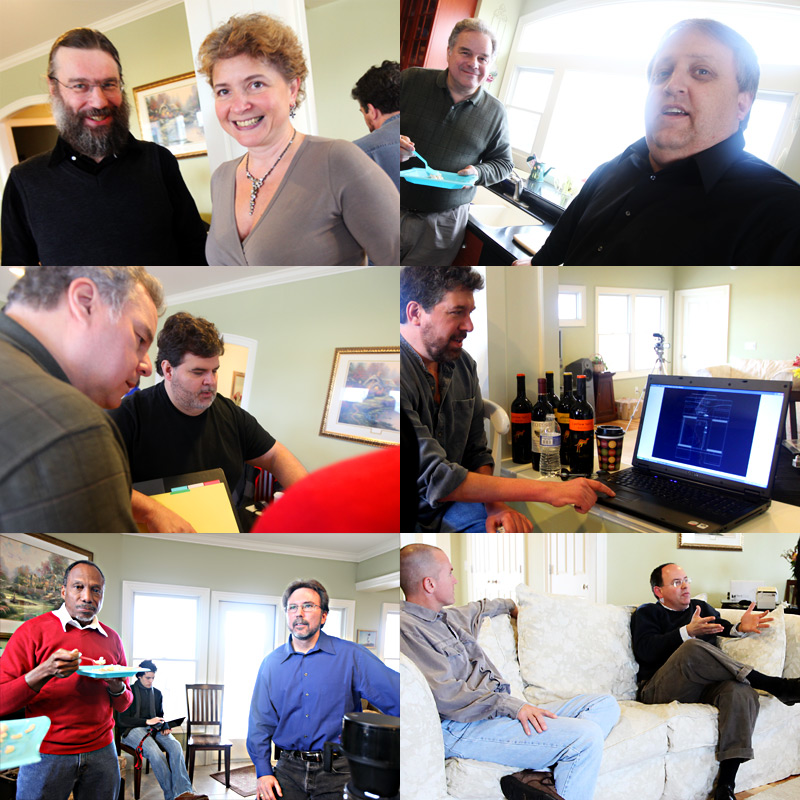
Middle left: Albert Bellg looks on as Mike Latvis
(Harmonic Resolution Systems) explains his stand designs.
Middle right: Andy Payor (Rockport Technologies) shows the speakers designs on his
computer and looks set to drink a lot of wine.
Bottom left: Simeon Sandiford
(SoundStage! Network) has lunch while Ron Lapporte (Blue Smoke Entertainment Systems)
looks on at the proceedings.
Bottom right: Jeff Fritz and Sam Laufer of Laufer Teknik (the US distributor for Behold)
during one of many conversations that weekend. |
TWBAS 2009 ran like
clockwork, starting bright and early on the 14th. I was one of the first to view the TWBAS
2009 system in what Jeff calls the "Music Vault," his dedicated listening room
that was custom treated by Terry Montlick Labs. Before I got to the room, I could tell
that Jeff was anxious. He had made big promises and didn't want to disappoint anyone,
including me. Walking into the Vault, I was more than a little surprised at the spectacle
that was before me, which included the rather surreal-looking acoustical treatments
specified for the room. It was all kind of space-agey, as the pictures show.
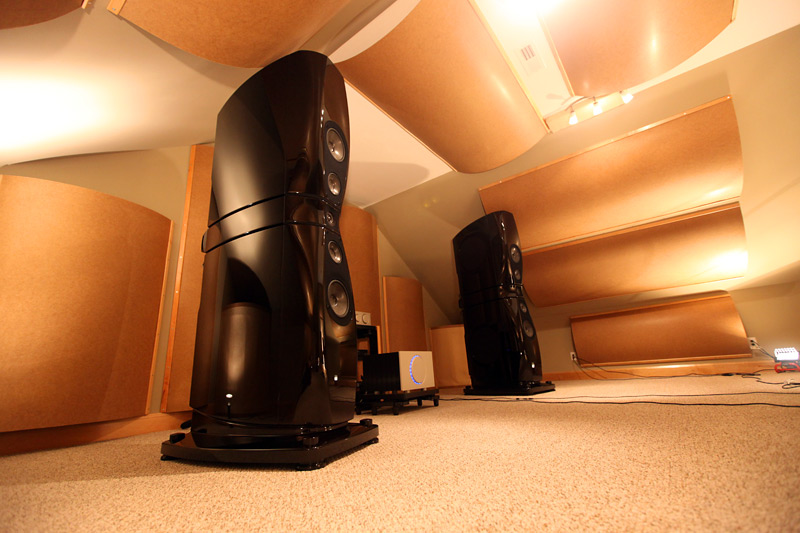
The equipment all stood to one end of the room,
with the listening chairs in the other. Harmonic Resolution Systems racks held the Behold
and Blue Smoke electronics, and everything was connected to AC power with Shunyata power
cords and power-conditioning products. Since the Behold electronics are
"digital," something I'll explain a bit more below, a lone Crystal Cable digital
interconnect was all that was needed to connect the Blue Smoke digital music music server
to the Behold preamplifier. Crystal Cable Dreamline speaker cables ran from the Behold
amplifier to the biggest attraction in the room, the Rockport Technologies Arrakis
loudspeakers.
The Arrakis is as impressive a loudspeaker as
you'll find anywhere. Each Arrakis stands almost seven feet tall and weighs over 900
pounds. The bulk of that weight is due to the cabinet, which is made from the company's
proprietary composite, which includes carbon fiber among other materials. These help to
render it acoustically inert. Rockport's goal: that the cabinet adds nothing to the sound.
I've seen a lot of speakers in my life, but
nothing I've encountered is built to the standard of the Arrakis. On the other hand, given
what the Arrakis costs, it should be well built. To own them, you'll have to open your
wallet wide -- a pair will cost you $165,000 and will take about three months to
build. You'll also need time, patience and money to get them installed. Each speaker comes
in three pieces but, even as separate modules, they were too big to fit through the door
to Jeff's listening room and up the staircase. Jeff had to cut holes in his walls to get
all the pieces upstairs. Once in the listening room, they were assembled there. There's an
entire photo
gallery of the initial setup procedure on Ultra Audio.
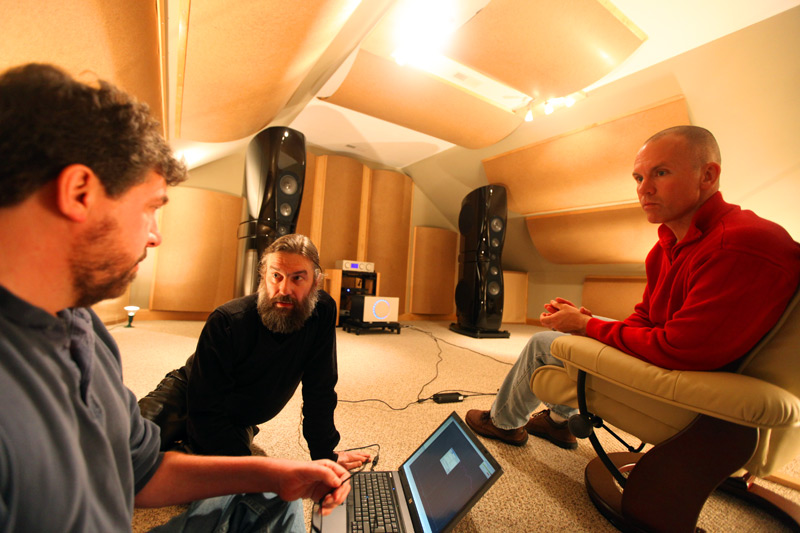
Andy Payor (left), Ralf Ballman (center) and Jeff
Fritz.
Jeff's setup was only step 1. Step 2 took place
before the masses were allowed to enter the room. While everyone mingled downstairs, Andy
Payor (Rockport's founder and chief designer) and Ralf Ballman (the brains behind Behold)
sat down (literally) with a computer, measuring equipment, and a suite of electronic tools
to optimize the performance of this stereo system for Jeff's room. Payor designs his
speakers to be ruler flat, but, as it is with every space, the room has a story of its own
and will inflict its own personality on the system. Their goal was to use the computer and
measuring equipment along with Behold's built-in room-correction software to make the
system as neutral as possible, which was exactly what Jeff wanted. So, while Payor and
Ballman worked, Jeff stood by and cracked the whip, and I hung out and took pictures.
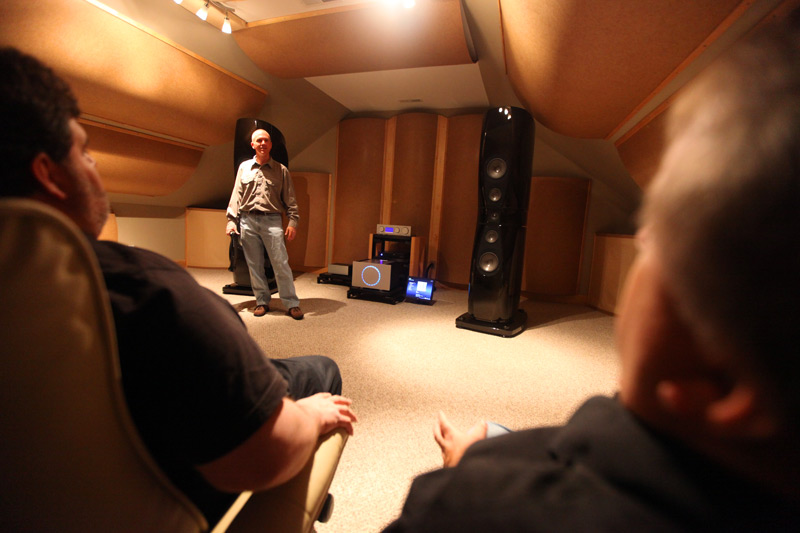
Jeff Fritz conducts the demonstrations for Mike Latvis
(left) and Grant Samuelson.
Since Jeff was the final decision maker when it
came to the sound, it was he who determined when Andy and Ralf were finished and the
system was ready for a public display. When that happened -- about an hour after Andy and
Ralf started -- the crowd made its way to the Music Vault. Jeff presented the system to
groups of four at a time so everyone had a place to sit and each person had listening time
in the "sweet spot."
So, is it?
Everyone agreed that the system was ambitious and
the results were more than impressive. In fact, I suspect most people in the world have
never listened to a system this good, nor will they ever get the chance to. But the
burning question in many minds is, "Is this the world's best audio system?"
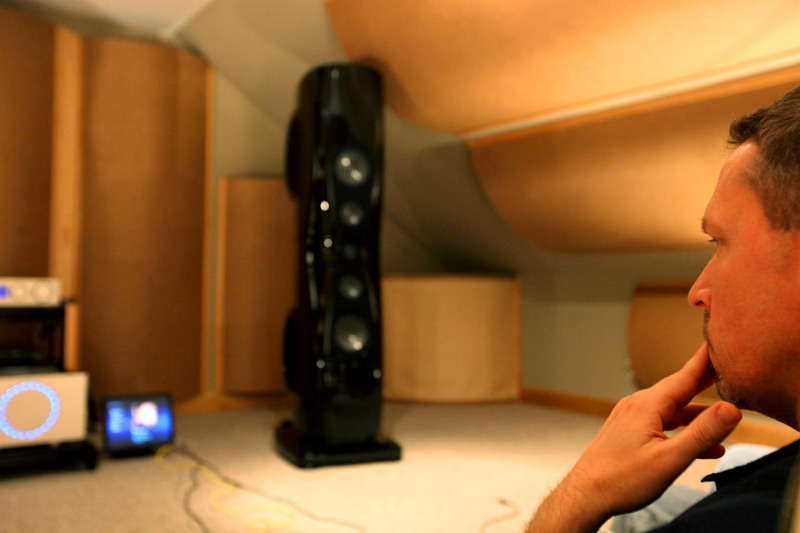
I listen.
To help answer that, I have to draw on my own
experience with the TWBAS 2009 setup. The only source was digital -- the music-serving
solution by Blue Smoke feeds a digital signal to the Behold electronics that, upon entry
there, upsample the signal to 768kHz and keep it in the digital domain until it's in the
power amp where it's finally converted to analog and then shoved through Crystal Cable
Dreamline wires into the Rockport speakers. There are plenty of music-serving solutions
nowadays, and there are plenty of speaker systems and cables too. But, as far as I know,
no other preamp/amplifier combination in the world operates like the Behold units do, one
of the reasons they were picked. The music server was pre-packed with everyone's favorite
demo music, including a few cuts of my own.
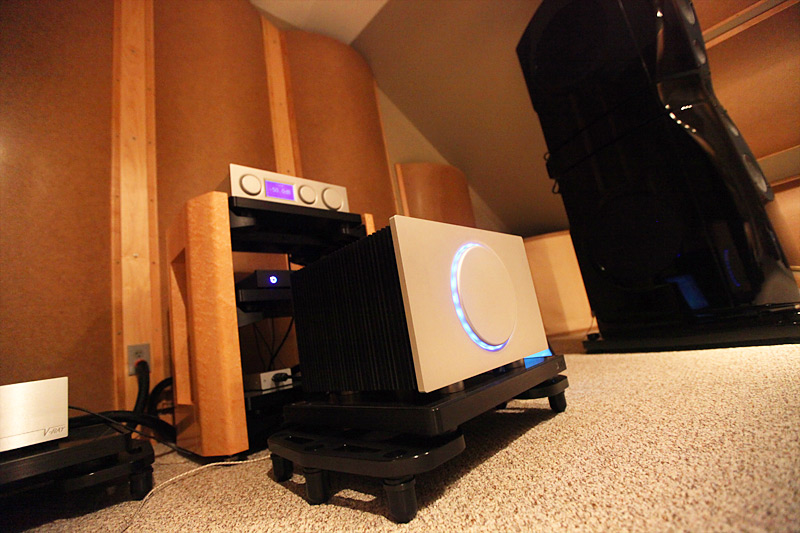
Behold!
I listened and concurred with the others that the
system was as ambitious as it was impressive. There was a grand, encompassing sound that
extended from the lowest limits of what you could hear in the bass straight up through to
the highs. Despite what Andy Payor said -- that he gets even better bass from the Arrakis
in his custom-built listening bunker -- the kind of heft that was heard in Jeff's room was
far more authoritative and impactful than most people have ever heard in their own rooms,
or anywhere else. This was definitely a full-range presentation.
The level of detail was also at the top of the
heap. Fellow writer Simeon Sandiford listened to a familiar recording and heard things on
it he'd never noticed before. I, too, listened to my music and was able to make out
nuances I hadn't noticed previously. Resolution-wise, it's hard to imagine the need for
more.
But TWBAS 2009 wasn't perfect. This was, after
all, still just a stereo -- and like every other stereo on the planet, it has limitations.
You had to sit right in the center to get the massive soundstage spread that the system
was capable of, and you had to have your ears at the correct height for things to sound
just right. There was definitely a tight sweet spot, horizontally and vertically. I also
found that the system could exacerbate the flaws in bad recordings, particularly in the
midrange. On the other hand, not everyone agreed with me on that point, and they thought
the super-high-rez presentation, one that readily revealed warts and all, was just right.
This goes to show you that it's hard, perhaps impossible, to get a consensus with these
sorts of things.
The purpose
After my brief listening session, I had to put
the critic in me aside and remind myself of the original purpose of TWBAS 2009. Although
we called it "The World's Best Audio System," we never really thought that if we
gathered a bunch of equipment and placed it in a room that it would automatically become
the best system out there. Great systems -- the best systems -- take time and
patience to build. You not only have to assemble the components, but match them
accordingly and then optimize it all for your room. A lot of that was done, but not nearly
the amount it takes to create something that someone can confidently say is the very best
in the world. Besides, there will always be differing opinions as to what the best is. As
I said, you'll never get a consensus.
Instead, the real purpose of TWBAS 2009 was to be
the start of something I had dreamed about for years -- a SoundStage! Network showcase
that exhibits the finest audio equipment in appropriate surroundings. With that in mind,
TWBAS 2009 was an amazing achievement, a complete success, not only in my opinion but
according to everyone who was there. The fact that the system turned out as well as it did
is icing on the cake.
TWBAS 2009 is the beginning of something new,
ongoing, and exciting. With what we have underway right now and planned for the future, it
might even revolutionize the industry and change the face of hi-fi shows forever. Prepare
to be blown away at TWBAS 2010, where at least 20 companies will have their equipment on
display in multiple rooms with surroundings like no one has ever seen at a hi-fi show
before. Jeff is already planning it, and it's something I can't wait to experience for
myself.
...Doug Schneider
das@soundstage.com
|

